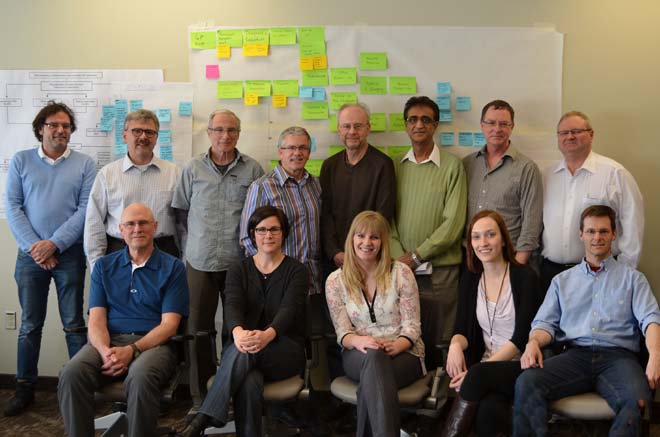From top left to right: Thomas Rotter, Dr. David Kapriva, Peter Barrett, Dr. Don McCarville, Stevin Lewis, Dr. Shanti Lala, Dr. Gary Groot and Dr. Bruce Berscheid.
From bottom left to right: Dr. Brian Ulmer, Tanya Verrall, Laura Schwartz, Jessica Hamilton, Gary Teare.
Missing: Dr. Bruce Du Val and Dr. Kylie Kvinlaug
A team involving Saskatchewan vascular surgeons and interventional radiologists is working to develop “best practice” standards for treating patients with arterial blood flow problems in their legs (lower limb ischemia). On March 2 the team met with members of the Variations and Appropriateness Working Group (VAWG) to identify key elements that should be incorporated into a care pathway and the data they’ll need to monitor care and evaluate patient outcomes.
On March 2 the team met with members of the Variations and Appropriateness Working Group (VAWG)* to identify key elements that should be incorporated into a care pathway and the data they’ll need to monitor care and evaluate patient outcomes.
Vascular surgery is one of several specialties with high variation in certain procedures in Saskatchewan. Vascular specialists here are keen to reduce variation among surgeons within Saskatoon and Regina, and across the two cities. Over the past few months, they have been reviewing variation data provided by HQC.
“The meeting was intended to get them all together under one roof for a day to visualize their system,” says Dr. Gary Teare, HQC’s director of measurement and analysis. “It was opportunity for them to describe the information they need to manage that system, and evaluate the value add of their work for their patients,”
Participating vascular specialists were Dr. Brian Ulmer, Dr. Kylie Kvinlaug, and Dr. Bruce Du Val (all from Saskatoon) and Dr. David Kopriva and Dr. Don McCarville (from Regina). The interventional radiologists that participated were Dr. Bruce Berscheid (Saskatoon) and Dr. Shanti Lala (Regina). Participating on behalf of VAWG were Drs. Gary Groot and Peter Barrett (Saskatoon surgeons and physician leads for VAWG) and Steven Lewis (consultant). HQC is actively involved with the VAWG project, in analysing data and facilitating team meetings.
Because vascular surgery is rapidly changing, with technology (surgical techniques and implant technology) constantly improving, published guidelines are always one or more years behind the development of evidence. As a result, any care pathway must be frequently reviewed and adapted to reflect emerging evidence. As well, any measurement system that’s developed must not only monitor compliance to a pathway but also enable learning and development of evidence to support change to the pathway over time.
After the Saskatchewan team mapped the different ways lower limb ischemia is currently treated in this province, they identified what data they’ll need to collect within specialists’ offices and hospital in order to monitor the impact of these different approaches over time.
HQC staff are now determining what data collection tools and processes already exist and what we’ll need to develop specifically for this project. The team will pilot paper forms in Dr. Ulmer’s (Saskatoon) and Dr. Kopriva’s (Regina) clinics starting in April. From there, we will develop standardized data collection tools and provide these to all the vascular surgeons and interventional radiologists in the province, with the aim to eventually move all data collection to an electronic system.
With the measurement system in place, the surgeons and radiologists will be able to monitor their care against the best practice standard they develop and will have information about the effectiveness of their care to improve patients’ health. Using this kind of feedback, they will be able to continuously improve and adjust their practice and measure the impact of those changes.
“There is much work ahead as we help them build their measurement and learning system,” says Dr. Gary Teare, HQC’s director of measurement and analysis. “Other surgical groups are already lining up for similar help. We are capturing learnings from this experience to help HQC become even better in supporting this kind of ‘clinical intelligence’ development in our health system.”
—
* The Variations and Appropriateness Working Group (VAWG) was established as part of the Saskatchewan Surgical Initiative (SkSI) to investigate variation in surgical practices across the province and engage surgeons in identifying best practice standards. VAWG is addressing the Smarter goal of the SkSI tagline “Sooner, Safer, Smarter.”



